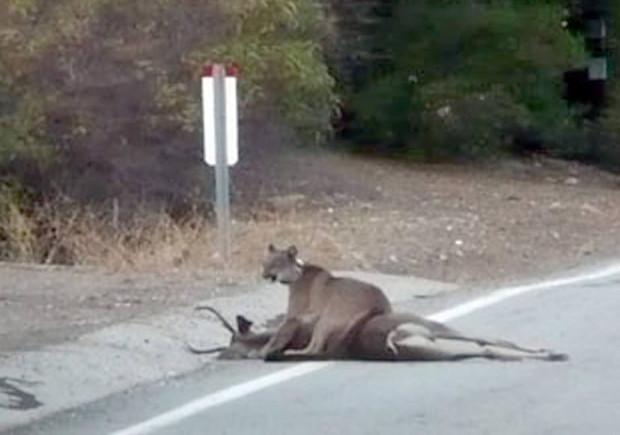natural predators of white-tailed deer

There are several natural predators of white-tailed deer with wolves (Gray, Eastern and Red species), cougars, American alligators, jaguars (in the American southwest, Mexico, and Central and South America) and humans being the most effective natural predators.
Aside from humans, these predators frequently pick out easily caught young or infirm deer (which is believed to improve the genetic stock of a population), but can and do take healthy adults of any size. Bobcats, Canada lynx, bears, wolverines, and packs of coyotes usually prey mainly on fawns. Bears may sometimes attack adult deer, while lynxes, coyotes, and wolverines are most likely to take adult deer when the ungulates are weakened by harsh winter weather. Many scavengers rely on deer as carrion, including New World vultures, raptors, foxes, and corvids. Few wild predators can afford to be picky and any will readily consume deer as carrion. Records exist of American crows attempting to prey on white-tailed deer fawns by pecking around their face and eyes, though no accounts of success are given.[Occasionally, both golden and bald eagles may capture deer fawns with their talons. In one case, a golden eagle was filmed in Illinois unsuccessfully trying to prey on a large mature white-tailed deer.
White-tailed deer typically respond to the presence of potential predators by breathing very heavily (also called blowing) and fleeing. When they blow, the sound alerts other deer in the area. As they run, the flash of their white tails warns other deer. This especially serves to warn fawns when their mother is alarmed.[Most natural predators of white-tailed deer hunt by ambush, although canids may engage in an extended chase, hoping to exhaust the prey. Fields typically try to suffocate the deer by biting the throat. Cougars and jaguars will initially knock the deer off balance with their powerful forelegs, whereas the smaller bobcats and lynxes will jump astride the deer to deliver a killing bite. In the case of canids and wolverines, the predators bite at the limbs and flanks, hobbling the deer, until they can reach vital organs and kill it through loss of blood. Bears, which usually target fawns, often simply knock down the prey and then start eating it while it is still alive.Alligators snatch deer as they try to drink from or cross bodies of water, grabbing them with their powerful jaws and dragging them into the water to drown.
Most primary natural predators of white-tailed deer have been basically extirpated in eastern North America, with a very small number of reintroduced red wolves, which are nearly extinct, around North Carolina and a small remnant population of Florida panthers, a subspecies of the cougar. Gray wolves, the leading cause of deer mortality where they overlap, co-occur with whitetails in northern Minnesota, Wisconsin, Michigan, and parts of Canada.This almost certainly plays a factor in the overpopulation issues with this species. Coyotes, widespread and with a rapidly expanding population, are often the only major nonhuman predator of the species, besides an occasional domestic dog.In some areas, American black bears are also significant predators.In north-central Pennsylvania, black bears were found to be nearly as common predators of fawns as coyotes.Bobcats, still fairly widespread, usually only exploit deer as prey when smaller prey is scarce.Discussions have occurred regarding the possible reintroduction of gray wolves and cougars to sections of the eastern United States, largely because of the apparent controlling effect they have through deer predation on local ecosystems, as has been illustrated in the reintroduction of wolves to Yellowstone National Park and their controlling effect on previously overpopulated elk.However, due to the heavy urban development in much of the East and fear for livestock and human lives, such ideas have ultimately been rejected by local communities and/or by government services and have not been carried through.
In areas where they are heavily hunted by humans, deer run almost immediately from people and are quite wary even where not heavily hunted. In most areas where hunting may occur deer seem to develop an acute sense of time and a fondness for metro parks and golf courses. This rather odd occurrence is best noted in Michigan, where in the lower peninsula around late August early September they begin to move out of less developed areas in favor of living near human settlements.
The deer of Virginia can run faster than their predators and have been recorded at speeds of 47 mi (76 km) per hour; this ranks them amongst the fastest of all cervids, alongside the Eurasian roe deer. They can also jump 9 ft (2.7 m) high and up to 30 ft (9.1 m) forward. When shot at, the white-tailed deer will run at high speeds with its tail down. If frightened, the deer will hop in a zig-zag with its tail straight up. If the deer feels extremely threatened, however, it may charge the person or predator causing the threat, using its antlers or, if none are present, its head to fight off the threat.


nockedup Massachusetts outdoors.